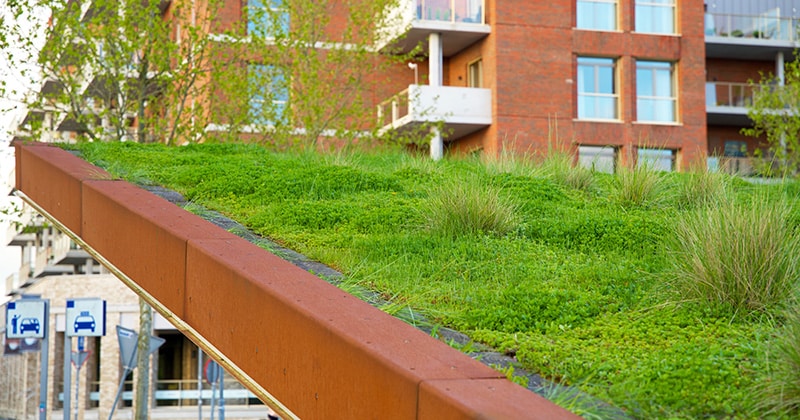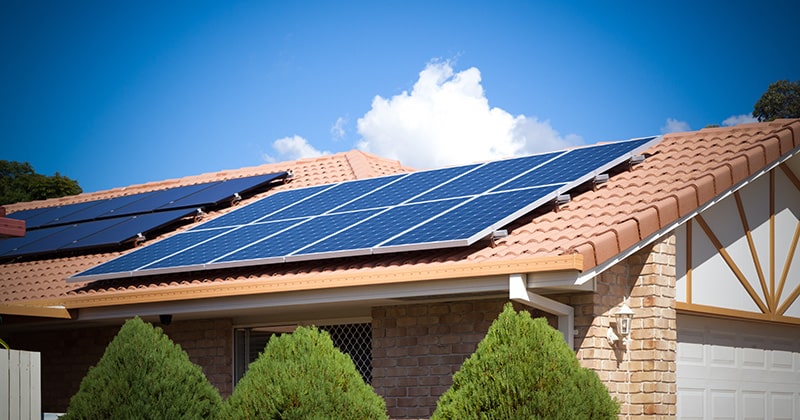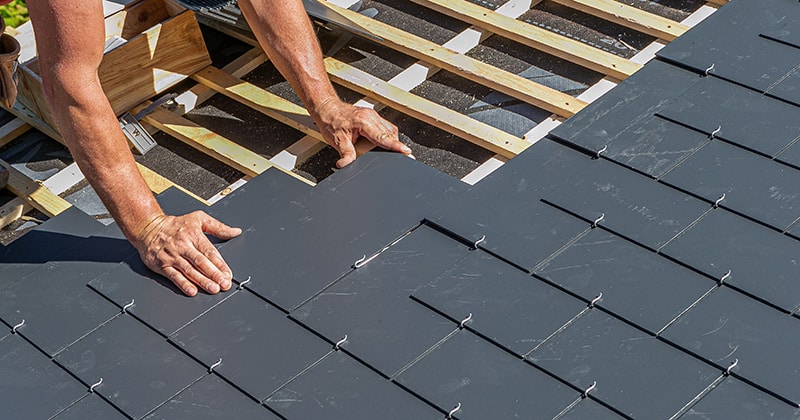9 Roofing Trends to Watch in 2023
A skilled roofer can guide homeowners to the best options for their budget, climate, future plans, and lifestyle. But, of course, you need to know the latest trends to provide that guidance.

Staff Contributor
The roofing industry never stands still. In fact, the construction, in general, is a dynamic field.
Market demands can shift drastically. This can create sudden changes in roofing preferences.
Roofing demands can be influenced by:
- Economics of real estate development
- Introduction of new roofing techniques
- Changes or interruptions of construction supply chain logistics
- Introduction of new legislation
Roofing contractors must be highly adaptive to cope with the industry’s fluctuations. You have to turn those fluctuations into business opportunities. And that’s not always easy—but we’re here to help.
In this article, we’ll outline some of the top trends affecting roofing today. We’ll be focused on disruptive roofing trends. In other words, these are the trends most likely to shake things up in the roofing industry.
Here’s what you need to keep a watch on in 2023.
Help Your Roofing Business Thrive With the Latest Trends
Are you looking for ways to help your customers upgrade their roofs?
There are so many roofing options on the market. And while it’s always great to have options, the sheer number of choices can make it difficult for homeowners decide.
That’s where you come in.
A skilled, experienced roofer can guide homeowners to the best options for their budget, climate, future plans, and lifestyle. But, of course, you need to know the latest trends to provide that guidance.
Here is what’s stirring in the world of roofing.
1. Roofs are going green

Green roofs are easily one of the most intriguing roofing trend today.
A green roof is essentially a rooftop garden. They’re beautiful—plus, they come with a fair number of advantages.
While there are many ways to create a green roof, all green roofs have a few things in common:
- Some kind of coating on a rigid roof structure to provide a solid foundation and waterproofing
- An insulating layer of soil
- A top layer with vegetation
Besides its enticing aesthetic appeal, a green roof is beneficial in many ways. For instance, according to the US Environmental Protection Agency (EPA), green roofing can reduce heat islands.
The vegetation lowers the roof’s temperature and absorbs heat from the surrounding air. This cooling effect results in significant energy savings. And that’s just one of many benefits.
2. Metal roofs are making a comeback
Metal roofs have long been used in agricultural and industrial structures. Zinc, copper, steel, and aluminum roofs are all quite popular.
More recently, metal roofs have become more popular for residential homes and commercial buildings, as well.
The global metal roofing market is expected to grow by a 3.5% through to 2030. Residential metal roofs are a significant part of that forecasted growth.
The 2020 Dodge Roofing Industry Report shows a growing preference for metal roofing among homeowners.
The renewed interest in metal roofing is thanks in part to improvements and innovations in metal roofing.
For example, modern metal roofing materials are made with longer-lasting weather-resistant alloys. They’re also designed to reduce noise and are finished in a wide range of attractive styles and colors.
3. Ditching the slope for flat roofs
Flat roofs are a common among industrial and commercial buildings. Interestingly, this roofing style is gaining popularity in residential homes too.
According to a recent report, more homeowners and entrepreneurs are opting for flat roofs. This is because flat roofs present some compelling advantages over sloped alternatives.
A flat roof design is more durable and cheaper to construct. It’s also aesthetically pleasing with its minimalistic modern look.
Another advantage is that flat roofs are incredibly versatile. They can be conveniently used to:
- Mount solar panels
- Hold HVAC units
- Grow a rooftop garden
- Expand the building’s dwelling space
4. Powering up with solar panel roofs

Solar power is one of the fastest-growing electricity source in the US. That’s do in part to an increased focus on renewable energy. Americans are invested in environmental issues and energy sustainability.
In fact, The US Solar Energy Technologies Office (SETO) plans to decarbonize the electric grid, with significant milestones as soon as 2035. For now, the private sector leads participation in this effort. Tesla, Sunrun, and SunPower, for example, are at the front of the pack.
What’s more, solar roofing systems are more creative than ever. And we’re not talking about bulky roof-mounted solar panels. Newer, more convenient options are being introduced.
Consider, for example, solar panels embedded in PV shingles and rail-less systems that integrate with the roof. These new options make residential solar energy far more viable.
5. Expanding range of synthetic roofing materials
There is growing interest in synthetic or composite roofing materials. These are roof tiles or shingles made from different synthetic materials. Most manufacturers use mainly rubber, plastic polymers, or fiberglass.
Composite roofs are growing popular for all the right reasons. They’re durable, cost-efficient, environmentally friendly, customizable, and easy to install.
Moreover, synthetic roofing materials expand the range of raw materials used for roofing. A wider variety of roofing options is a welcome relief. The ongoing material shortage has plagued the industry.
Synthetic roofing materials can even be made from waste products. Companies like Toitures Polygram and Plastic Smart Cities are developing synthetic roofing tiles from recycled waste plastic.
6. Cool roofing to beat the heat
A roof’s “coolness” is measured by its Solar Reflective Index (SRI).
SRI is determined by two main factors:
- The roof’s ability to reflect solar energy—solar reflectance
- The roof’s ability to reflect absorbed solar energy—thermal emittance
Cooler roofs have a higher SRI rating. The Cool Roof Rating Council (CRRC) assigns SRI values to roofing materials through a third-party roof rating program.
You can build a cool roof using naturally cool materials such as slate or clay. Alternatively, you can coat regular roofing shingles with a high-SRI material. A green roof is also a cool roof.
The point of cool roofing is to minimize the heat coming in through the roof during the daytime.
Less heat means lower cooling costs. As a result, cool roofs are becoming increasingly popular, especially in warmer regions.
7. Asphalt shingles are still holding up
The Dodge Roofing Industry Report shows that asphalt is by far the most popular roofing material.
Asphalt shingles have remained a go-to roofing solution for all types of buildings. However, much has changed in the manufacture and installation of asphalt shingles.
Decades of improvements and innovations have only made this time-tested roofing style better.
Modern asphalt shingles are:
- Durable
- Versatile
- Weatherproof
- Easy to install and repair
- Recyclable
- Fire resistant
- Affordable
Despite the growing popularity of newer roofing methods, asphalt shingles remain a popular, sensible choice.
8. Slate shingles rekindle an old roofing style

Slate roofing is one of the oldest roofing techniques in the world. Its history stretches back to the Middle Ages. Slate was used for roofing castles and military buildings throughout western Europe.
But it wasn’t until the mid-19th century that slate was mass quarried in the US for general construction. Slate roofing has come a long way since those early days.
Today’s slate shingles are:
- Lighter
- Easier to work with
- Available in sleeker designs
9. Exciting tech applications in roofing
Digitization is taking the world by storm. The roofing business has not been left behind.
For instance, roofers can use highly specialized drones to:
- Survey and monitor work sites
- Inspect buildings
- Deliver material to hard-to-reach places
Other technologies, such as 3D modeling, AR and VR, and smart work gear, are making roofing jobs safer, faster, and more efficient.
Looking Forward in the Roofing Industry

Emerging roofing trends can easily impact your roofing business. They’re closely tied to customer preferences and industrial norms. So, they may determine the demand for certain roof repair or installation services.
Keep an eye out for any new roofing trends. Keeping up to date can make all the difference in future-proofing your roofing company.
Lisa loves words—particularly how they have the potential to transform lives when shared with positive intent. When she’s not connecting the dots for writing projects, she is outside enjoying everything nature says with no words.

Business Solutions For Field Service Pros
EverPro offers specialized solutions designed for home and field service professionals. We’ve got the business tools to help you get the job done.



